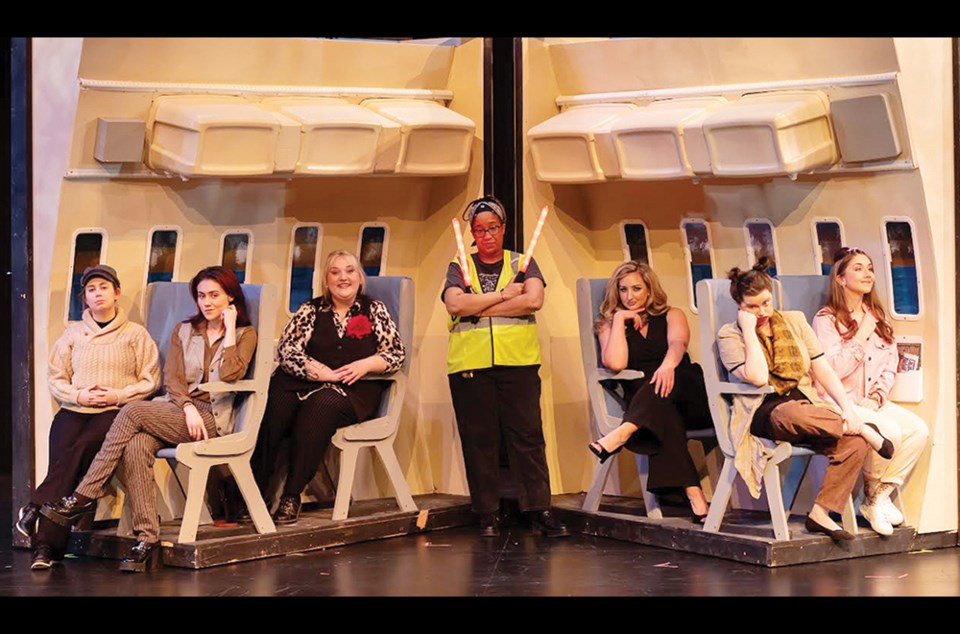It’s a challenging tightrope, indeed, to both lampoon those who inhabit the sometimes ever so slightly pretentious world of the “legitimate theater” (as Miss Arlene Francis used to put it) while not falling into the very traps one is playfully satirizing.
And in The Arlington Players’ serio-comedic play-within-a-play production of “Anton in Show Business,” there fortunately are more hits than misses, even though the subject matter seemed to slightly baffle some of the troupe’s core audience.
Set at a San Antonio regional theater in the midst of rehearsals of Anton Chekhov’s “Three Sisters,” the show takes playful swipes at everything related to the middle ranks of the theater world – actors, directors, producers, audiences, underwriters, even critics (how very dare they) – at the dawn of the 21st century.
(If anything, the idiosyncratic behavior of each of those groups has only become more pronounced over the ensuing quarter-century, making the behavior playing out on stage almost quaint by comparison.)
The three leads playing, you guessed it, Chekhov’s three sisters, are performed by:
• Mikel Gajkowski as the TV star enlisted to bring in audiences and burnish her résumé in hopes of landing coveted film roles.
• Lori Brooks as “the queen of Off-Off-Broadway” (“200 plays without ever receiving a salary”), the 30-something hoping that winning roles that pay the bills will allow her to quit her day job at the slaughterhouse.
• Emily Gjovik as the youngest, a third-grade teacher with a Texas twang and modest community-theater background given a chance to make her mark in the semi-big time.
To the great credit of the performers themselves, plus playwright Jane Martin (more on her later) and director Hilary Adams, all three come off as real people – hard enough to pull off in any play, let alone one about theater folk themselves. Even crusty ol’ reviewer Matt is rooting for them. And how often does that happen?
Mary Rodrigues is a familiar character to those who know their regional theater – the artistic-director-cum-producer with one foot in the real world of having to pay the bills while also dealing with the fantasyland of creative folk. A good job there.
Grace Murtha gets to chew some scenery in a number of roles, including two of the parade of directors who come and go, while Kalynn Henderson is the front-row audience member perpetually punctuating the proceedings with commentary.
Vanea Pharr, who portrays roles ranging from the stage manager to a cigarette-company executive, deserves a special shout out because (a) this is her first community-theater production and (b) she showed exceptional range. Can’t wait to see more of her.
Director Adams has fashioned a taut production of just over two hours, although the script seems to linger unnecessarily toward the end. The creative team (among them Skip Gresko, set design; Anna Marquardt, costume design; Griffin Voltmann, properties design; and Robin Maline and Lanae Sterrett, hair and makeup design) was effective in adding to the ambiance.
In her director’s notes, Adams makes a point that the show, designed for an all-female cast and in this performance helmed by a female producer, director and stage manager, is helping to break the male stanglehold that has held sway in the American theater since … well, since the beginnings of the American theater. True and laudable, but it also is worth noting that “Jane Martin” the playwright is a pseudonym for a writer whose identity has never been firmly established, but one who most sleuths of a thespian bent have pinned on a male. (In the immortal last words of “Some Like It Hot”: Nobody’s perfect.)
Warts and all, I liked the show, alternately chuckling out loud at the clever throwaway lines and feeling the depths of the pathos when it arrived.
The reaction of the rest of those in the opening-weekend Sunday matinee seemed a little more subdued, which brings up one of many challenges for theater at all levels these days, but particularly at the community level.
Audiences (typically older, mostly of the caucasian persuasion and economically upper-middle-class or above) have been acclimatized through the years to theatrical comfort food, and when troupes try something a little more unconventional, those existing audiences may take the route of old soldiers and just fade away. (To its credit, “Anton in Show Business” addresses this point, too.)
Arlington’s Dominion Stage, once the Fairlington Players, morphed from traditionalistic to more aggressively adventurous in its selections more than a decade ago. The typical community-theater crowds largely dissipated and, to a degree, newer ones (albeit in smaller numbers) materialized. It’ll be interesting to see what route The Arlington Players opts to take.
• • •
“Anton in Show Business” continues through Feb. 18 at Thomas Jefferson Community Theatre, 125 South Old Glebe Road in Arlington.
Producers note that adult language and themes are present; I’d say the show is OK for mature teens and above.
For tickets and information, see the Website at www.thearlingtonplayers.org.



